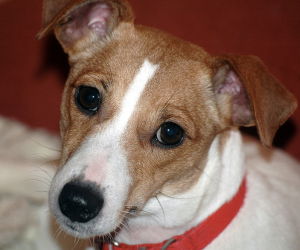Can Dogs Really Feel Guilt?


As we have discussed previously, dogs excel at reading emotions and intentions of their humans (see blog ‘You can’t lie to your dog’). As we notice the dirty deed, we have a knee-jerk emotional reaction, an internal ‘oh no!’ that the dog will immediately pick up. In order to avoid scolding, Bailey will do what comes natural to him and express appeasement signals. He may look guilty, but what he’s really feeling is fear of being scolded. This is not an indicator of his ability to draw any correlation with the act he committed. That’s already in the past, what’s here, right now, is an upset owner and a puddle on the floor. After a few repetitions, Bailey may start expressing the same fear signals prior to Sam’s notice of the puddle. Just like us, dogs are designed to notice patterns, so it won’t take long for the dog to learn that puddle on the floor and presence of owner is bad news.
In an informal attempt to illustrate this point, Ann Ronayne and I set up a situation where Heaven, a sweet golden retriever is scolded, as Ann places either trash on the floor or poop collected from the backyard. In either case the dog had nothing to do with the deed, but it only took one time for her to start expressing the body language described above as Ann enters the room (see video below). Let me assure you though, that after the session was over, Heaven was given ample attention and treats to make up for the unpleasant set up.

In a more formal study on the subject, Alexandra Horowitz (2009), from Barnard College in New York, and author of the excellent book ‘Inside of a dog’, demonstrated that, whether or not the dog appears guilty to the owner has nothing to do with what he actually did. In the study, owners were asked to leave the room after having ordered their dog not to touch a treat intentionally left in their reach. As the owner was gone, one group of dogs was fed the treat by the experimenter, the other group was not. When the owners came back, they were either told that the dog had behaved and left the treat alone, or that the dog had disregarded their order and had ingested it. What the owners did not know, is that they were being manipulated and what they were told about how their dog behaved, was not necessarily true. The results of the study revealed that the ‘guilty’ look on the dog had little to do with whether or not he had ingested the forbidden treat. It had everything to do with how the owner reacted when given the news.
Research seems to indicate that our dog’s mind, with all its mental abilities and emotions, is roughly equivalent to that of a 2 ½ year old human child (Stanley Coren, 2013). These findings would suggest that dogs would have similar emotions to human children, yet not as many as human adults. The more complex emotions, such as shame, pride, guilt or contempt appear only between 3-4 years of age. So according to these studies, our pooches will have all the basic emotions such as joy, fear, anger, disgust and even love, but not the more complex ones such as guilt, pride or shame.
These findings clearly demonstrate one of the many misunderstandings that can occur between humans and their pets. It’s quite natural for us to interpret our dog’s behavior as we would that of another human. However, although close friends, dogs and humans are two different species with two different thought processes. Many more studies are still needed for us to better understand this animal that we’ve lived with for so many years. In the meantime, the best we could do is giving him the benefit of the doubt and stay tuned as science keeps making progress on dog/human relationships.
Jennifer Cattet, Ph.D.



Leave a comment